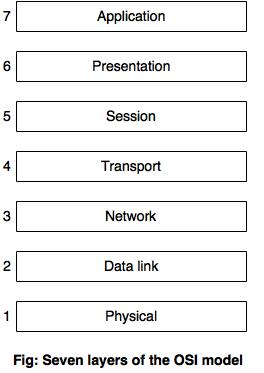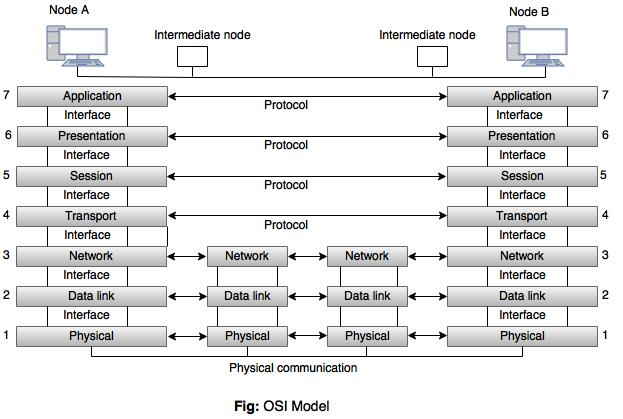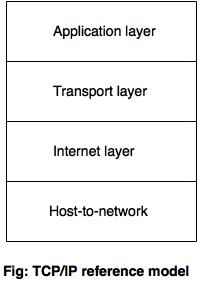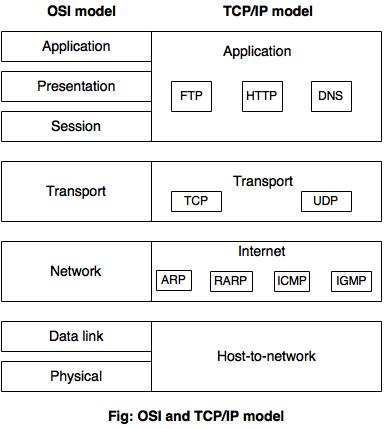Protocol Layers and Reference Models in Computer Network
Layered Architecture
- The OSI model is made up of seven layers: Physical, Data link, Network, Transport, Session, Presentation and Application. These layers are involved when a message is sent from one computer to other computer.
- When the message travels from source to destination, it pass through many intermediate nodes.
- These intermediate nodes involve the first three layers of the OSI model.
- Each layer defines particular network functions.

OSI Model
- The Open System Interconnection (OSI) reference model describes how the information moves from one computer to another computer through a network.
- This model was developed by the International Organization for Standardization (ISO) in 1984.
- This model is used for understanding and designing a network architecture that is flexible, robust and inter-operable.
- OSI model has seven separate but related layers : Physical, Data link, Network, Transport, Session, Presentation and Application.
Each layer defines a part of the process of moving information across the network.
 Interface between layers
Interface between layers
Interface is responsible for passing the data and network information down through the layers of the sending device and back up through the layers of the receiving device.
1. Physical layer:
- Physical layer is the lowest layer of the OSI model.
- It coordinates the function required to transmit a bit stream over a communication channel.
- It defines the procedures and functions that physical devices and interfaces have to perform for transmission.
- Physical layer also defines the direction of transmission between two devices. Direction may be simplex, full-duplex and half-duplex.
2. Data link layer- Data link layer is responsible for transmitting the data over the channels.
- It is used to divide the stream of bits received from the network layer into manageable data units called frames.
- It adds a header to the frame to define the sender and receiver of the frame.
- Data link layer detects and corrects the transmission errors using the correction method.
3. Network layer- The network layer is responsible for the delivery of a packet, across multiple network.
- It specifies the intra-network operations and different types of addressing and routing devices.
- Network layer also provides the logical and service addressing and switching control.
4. Transport layer- The transport layer specifies the process to process delivery of the entire message.
- It is responsible for flow control and error control.
- The transport layer of sending device makes sure that the entire message arrives at the transport layer of receiving device without error.
5. Session layer- Session layer is the network dialog controller.
- It is used to establish, maintain and synchronize the interaction among communicating system.
- Specific responsibility of session layer is dialog control.
6. Presentation layer- The presentation layer is responsible to translate the information in to bit streams before transmission.
- It is also responsible for data encryption, data decryption and data comprehension.
7. Application layer- Application layer allows the user, whether human or software, to access the network.
- This layer provides user interfaces and application services for file transfers, e-mail, and other network software services.
TCP/IP Model
- TCP/IP means Transmission Control Protocol / Internet Protocol.
- TCP/IP model is a four layer model and the layers are host-to-network layer, Internet layer, transport layer and application layer.
- The three topmost layers (application, presentation and session) in the OSI model are represented in TCP/IP by a single layer called the application layer.
- The host-to-network layer in the TCP/IP model is equivalent to the combination
of physical and data link layer in the OSI model.

 Host-to-network
Host-to-network- Host-to-network layer does not define any specific protocol.
- It supports all the standard protocols.
- It is responsible for accepting and transmitting IP datagrams.
- The TCP/IP network can be a Local Area Network (LAN) or a Wide Area Network (WAN).
Internet layer- At the Internet level, TCP/IP supports IP, ARP, RARP, ICMP and IGMP protocols.
- All these protocols handle machine to machine communication.
IP – IP is the primary protocol, which is used to transport data in packets (datagrams). Each packet is transported separately.
ARP – The Address Resolution Protocol is used to associate a logical address with a physical address.
RARP – The Reserve Address Resolution Protocol is used to discover host's Internet address when it knows only its physical address.
ICMP – The hosts and gateways use the ICMP (Internet Control Message Protocol) mechanism to send notification of datagram problems back to the sender.
IGMP – The Internet Group Message Protocol is used for simultaneous transmission of a message to a group of recipients.
Transport layer- UDP and TCP are the transport layer protocols.
- These protocols are responsible for delivery of a message from one process to another process.
TCP – TCP converts the incoming data stream into smaller units called segments and passes each one into the internet layer.
UDP – This is a connectionless protocol. It adds only port address, checksum error control and length information to the data from the upper layer.
Application layer- The application layer protocols are: SMTP, FTP, HTTP, DNS, SNMP TELNET and so on.
- TELNET is the Network Terminal Protocol, which provides remote login over the network.
- SMTP is used to deliver the electronic mail.
- FTP is used for interactive file transfer.



